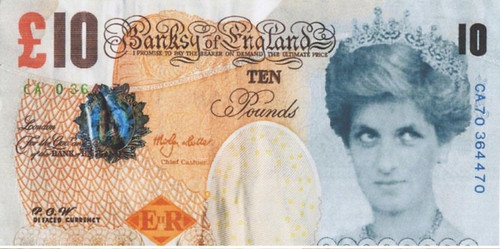
PREV ARTICLE
NEXT ARTICLE
FULL ISSUE
PREV FULL ISSUE
BRITISH MUSEUM ACQUIRES BANKSY £10 NOTEThis February 1, 2019 ArtNet article describes the British Museum's acquisition of a banknote created by the artist Banksy. -Editor   The British Museum has added its first piece by notorious British street artist Banksy to its collection, and the piece is a counterfeit–counterfeit currency, that is. In 2004, Banksy printed £1 million worth of fake £10 notes that replaced the visage of Queen Elizabeth II with that of late Princess Diana. Banksy then dropped the money on crowds at the Notting Hill Carnival and at the Reading Festival. Banksy's management company and authentication entity, Pest Control, has now donated one of these bills to the museum, according to the Art Newspaper. It is titled Di-faced Tenner, a play on the word "defaced." Issued by the "Banksy of England," the currency reads "trust no one" on the verso, which features Charles Darwin. The bill will join the British Museum's department of coins and metals (rather than prints and drawings). Although the British Museum doesn't have any immediate plans to exhibit Di-Faced Tenner, it turns out that Banksy has already shown some of his other work there, albeit clandestinely. In 2005, he surreptitiously installed a fake cave painting, Peckham Rock, featuring a hunter pushing a supermarket cart, in the museum's Roman Britain gallery. The prank is said to have gone undetected for three days. "It was the cause of considerable embarrassment for the museum at the time and when Banksy asked for it back we were only too pleased to oblige," British Museum curator Tom Hockenhull told the Guardian last May. (The museum later asked for it back on loan to include as part of a 2018 group show on dissent.) To read the complete article, see: Here's some more from The Guardian. -Editor "There is a long history of political and social discourse through this type of protest which made us keen to acquire it," Hockenhull said. "Also, it's a Banksy – why wouldn't we want it? It's an opportunity for us to have a work by an artist of that stature as part of a collection that people might not consider the typical respository for a work by Banksy. "From our perspective, it joins a long list of artists who have created, adapted or destroyed currency for the purposes of their work." The artist described the origin of the Diana £10 notes in his 2010 Oscar-nominated film Exit Through the Gift Shop, saying he had made £1m pounds worth, planning to throw them off a building. He had handed some notes out at Reading festival, but realised the stunt was backfiring when people started taking them to the bar to spend. "It was like, holy shit, we just forged a million quid, and obviously for that you'd go to jail for ten years." Distribution was speedily halted. To read the complete article, see: QUESTION: Does anyone know if these pieces all have the same serial number? Printing a different number on each note requires special equipment to be done efficiently, and a million pounds worth of these were created initially. The specimen acquired in 2016 by the American Numismatic Society (see the earlier article linked below) shows the same serial number. -Editor To read the earlier E-Sylum article, see: Wayne Homren, Editor The Numismatic Bibliomania Society is a non-profit organization promoting numismatic literature. See our web site at coinbooks.org. To submit items for publication in The E-Sylum, write to the Editor at this address: whomren@gmail.com To subscribe go to: https://my.binhost.com/lists/listinfo/esylum All Rights Reserved. NBS Home Page Contact the NBS webmaster 
|